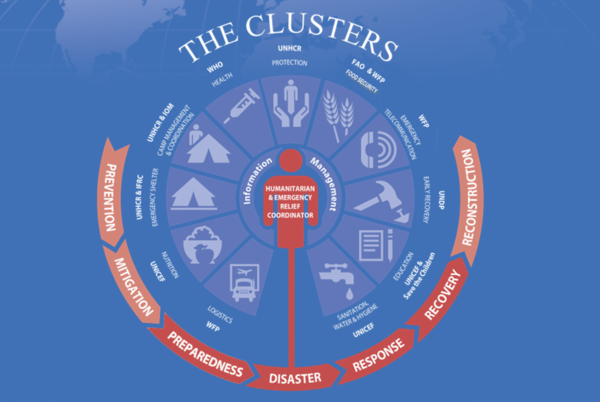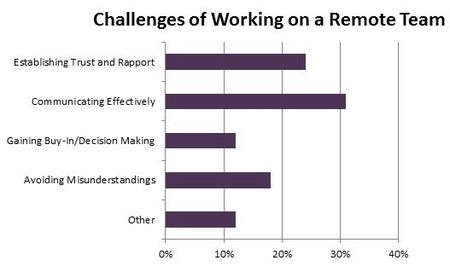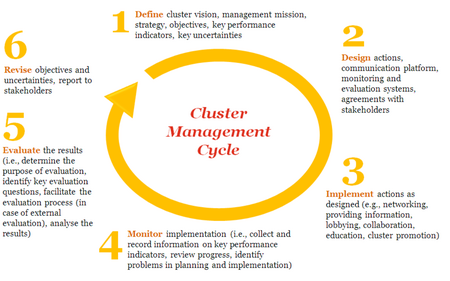Management of remote project
(→Cluster: a new way of teamworking) |
(→Cluster: a new way of teamworking) |
||
| Line 108: | Line 108: | ||
*Evolving team members: If new skills are required, new members will enter in the cluster. | *Evolving team members: If new skills are required, new members will enter in the cluster. | ||
*Self-organized: Clusters have their own structure and rules. | *Self-organized: Clusters have their own structure and rules. | ||
| + | |||
| + | ==Development== | ||
| + | |||
| + | [[File:Developement.jpg]|rigth|thumb|Steps to develope a cluster <ref >https://infographiclist.files.wordpress.com/2012/01/jeffparksarchivesrebeccahopeandmotive8infographics_4e5bb0c24073b.jpg</ref>] | ||
=Conclusion= | =Conclusion= | ||
Revision as of 13:28, 16 September 2016
Coordination of Remote Project: a cluster approach
Aid workers are subject to multiple attacks. Acting in insecure area could mean for the NGO (Non-Governmental Organization) huge expenses in security management. Thereby more of them prefer use remote management to secure their international staff in a secure place. However, the remote control or remote management can lead to risk transfer to local team, wrong accountability or monitoring. Generally, whole those consequences are due to a bad planning and remote control was implemented in emergency situation. However, if it’s implemented and correctly planned in the early stage of the project it could really help the NGO to still provide aid to highly insecure area.
Moreover, all the lessons learned from the aid remote project can be adapted to general companies. The cluster approach could be one of the method to introduce a more predictable and accountable means for coordination by formalising the lead role to some specific organisation. Cluster management cycle is important to understand and implement in order to achieve the common aim. Indeed, with our virtual and globalized world companies tend to have more geographically dispersed teams. Moreover, some companies are working with university in knowledge clusters. Those teams face some of the same problems of the local aid workers. Some recommendations will be described in order to learn from the lessons of the NGO who have faced similar problems.

Contents |
Remote Project Management
Remote project management or remote control is defined as reducing or restricting movement or withdrawing internationals (or any other staff at particular risk) while shifting responsibilities for programme delivery to local staff or local partners. [2]. It was first adopted in the conflict in early 1980s. However, only few documents explained the good practice of this kind of management and how to succeed. ‘Remote control’, ‘remote support’ and ‘remote partnership’ and ‘limited access programming’ are different concept for remote management that it could be find in the literature [3]
Key Challenge in the Coordination of dispersed teams

This kind of management has several negative side as risk transfer on local team or poor quality and coordination. But those are due to a short-term decision-making attitude. The cluster approach that will be explained latter resolve some of these drawbacks.
Trust
As local NGO should have trust in their international management, dispersed teams should have the same behavior with the Head Offices. It enforces the formation of cohesiveness between team members. If there is not enough trust between the teams, they will have some difficulties to face challenge and even sometimes blame each other. Moreover, the local NGO has a better understanding of the problem but international headquarters have experience from different and previous experience, Therefore, scattered teams should understand the skills of everyone and use them with trust.
Difference in Time zones, language and cultural barriers
An American NGO operating in Afghanistan with a local supplier will have some issue with the communication. Indeed, because of the difference in time zones that impose some delay in the reaction mostly in emergency situation. Moreover, there could be some misunderstanding because of the difference in language.
Technical issues
First, an easy solution to resolve the different in time zones could be using low bandwidth communication channels, such as emails or documents, which generates large amounts of lost or misunderstood information[4]. Therefore, video and deskopt sharing should be use instead to promote face-to-face communications.
Then, people from different countries use different technologies. Americans will prefer Microsoft Office and the Chinese more open-source software.When the team are in the same building, those problems generally will be resolved by day-to-day communication[4] but for remote project it will be impossible. Therefore, a clear definition of which programs should be used must be done before starting the remote project.
One solution: a cluster approach
As it has been described, remote management can lead to coordination issues. In order to resolve that, the cluster approach was introduced in 2005 [2]. Thereby the lead role was more formalized among the different organisations. The cluster approach is defined by a Cluster lead, the lead coordinator for a specific area of response which is responsible for organizing coordination at global and country level, prepare global planning, guidance and acting as a last resort [6]. Then, there are the lead agencies for each area of activities/clusters: logistics, camp management, etc. The cluster approach is now used in 43 countries to respond to any kind of emergency project [7]
Notable Benefits
Even if this approach is still to be improved, notable benefits have been identified in different fields like gap identification, coordination or information sharing.
Gap identification and Coverage
Thanks to a better collaboration between the agencies, it was possible to reduce the humanitarian efforts on site. Moreover, it was possible to identify the missing services inside the cluster and correct it. [8]. Indeed, the cluster approach allows to have a collective response to a specific problem. Before that, the origin of the gap will be defined thanks to the information sharing.
Coordination and leadership
This double managing structure with on one side the Cluster lead and on the other side the cluster agencies responsible for one sector, allows to clearly understand the responsibilities of everyone. This sectorial agencies are in charge of ’’ ensuring response capacity in place and that assessment, planning and response activities are carried out in collaboration with partners and in accordance with agreed standards and guidelines” [7].What make the cluster approach working is the fact that all the team members are working for the same common humanitarian objectives [7].
Monitoring,evaluation and Information sharing
Before the implementation of cluster approach in the humanitarian response, each member collected information but they are not sharing between the agencies. Trough cluster they can now share valuable information, analysis, strategic planning and evaluation. <ref=boom></ref>. Thereby this system improves the understanding of an pressing issue and let easy to find an appropriate response.
Cluster management cycle
The cluster approach is a way to implement in aid project but it can be also implemented in conventional companies who are dealing to international partners or teams. Cluster management is defined as a perpetual cyclic activity. It’s a complex, interactive and non-linear process. [9]. There is so a need in an adaptive management structure. Five stages can be looked at:

- Define
- Design
- Implement
- Monitor
- Evaluate
- Revise
Define
In order to have clearly defined objective, the first step is to define the expected results for the cluster. A clear vision of the long term future of the cluster should be defined. It represents the strategic planning. For example, the WHO (World Health Organisation) cluster defines is vision as promoting health in the world. Another important recommendation is to identifying key uncertainties. As in insecure environment, the cluster manager is working in a highly uncertain environment and should act despite unpredictability. Key uncertainties for NGO or companies could be: [9]
- continuity of commitment of the key stakeholders
- finance instability
- change in technological and regulatory field
In order to succeed in cluster management, the vision and strategy should be developed with all clusters members. Moreover, the goals even in emergency situation should be measurable and feasible. Then, each clusters member should understand what are the benefit of this type of coordination.
Design
After defining objectives, they have to be performed. As it has been seen, one key challenge is to maintain a clear communication between the different stakeholders. Because of the difference is technologies, language it can become a hard task to manage. Therefore, two different plants should be presented. First, an action plan has to be implemented in order to highlight the activities, the responsibilities related, planning and allocation of the resources [9] For each objective there has to be indicator for success and measurement. Thereby, a data collection could be performed afterwards. However, those indicators should be well chosen in order to avoid an overload of information. Then, a communication plan in order to promote positive association, behaviour between the members. Several questions should be answered in this plan like “Who are the Stakeholders?” the communication mechanisms, etc. As in emergency situation is important to maintain a regular contact with the local suppliers. The frequency will differ following the role of the cluster member in the crisis as in the project for the companies. However, the communication mechanisms (software, etc) have to be clearly characterize with all the stakeholders. Finally, all the cluster members should accept a governance agreement for the decision making and communication.
Implement
Once the design approved, the implementation has to start. Here also a similarity could be seen between the operational actions of NGO and companies: the networking, providing information, collaboration, training, etc. [10]
Monitor
Monitoring is extremely important to gather crucial information on the different projects. To have useful information the members must know which kind of info should be collected, their form and the involved people. To have a good monitoring it should be done on a systematic way and regular basis. [9] There are two ways for monitoring the activities or on a process-related indicator (that should be defined in step 1) or continuously collect information on the outputs[11]. However, this last method requires a big involvement of the cluster member to share uninterruptedly their information. For emergency case, it could very interesting but in other case it could impede the correct working of the sectorial group. The goal of monitoring is to adapt and check if the cluster is acting in the right way. Moreover, it allows to identify problems in planning and/or implementation.
Evaluate
Comparing the actual effects with the decided strategies at a define moment is called evaluation[9]. It differs from monitoring in the way is done. Monitoring is continuous and evaluation is at a precise moment. Moreover, the evaluation report if the objectives were reached, the strong and weakness of the cluster. Nevertheless, if there is a correct monitoring, the evaluation should be right as well. Two types of evaluation could be highlighted: the formative and the summative. They form together the complete evaluation.
- Formative
The purpose is to analyse the organisation of the cluster.
- Summative
The goal is to look at the improvement of the development of the cluster and its local impact. Then, another purpose of the evaluations is for decision policy. The evaluations are a way to justify certain decisions certainly in difficult contexts. Finally, it is extremely important for the experience and the development afterwards. Lessons could be learned and the action plan established in step 2 could be changed
Revise
The final step of this cyclic process is to review objectives and uncertainties taking into account the previous stages. After that the lessons learned and results must be spread with the stakeholders or in the company.
Cluster: a new way of teamworking
Over time the effectiveness of a team decrease. [12]. Once the project done and not a real recognition from the company for the team, then the motivation could despair. Cluster team are totally the opposite of conventional team. They are by definition outside the company “but are hired and paid by companies as a unit, as a permanent part of the company” [12]. It is like a company unit inside a company. They have their own way of working and divide the remuneration. However, they are not doing consultancy in the way that they are hired for the long term and have their own working tools and methods. They are multi-disciplinary, multi-functional collaborative networks to drive optimal outcomes. They come into being to address a particular challenge, and then dissipate to form other networks addressing other challenges[13]
Regardless of the type of cluster (geographically dispersed or not), the following aspects are present[13]:
- Custom-made Plan: operational objectives and schedule. It represent the purpose.
- Defined timeframe: when there is a need, the cluster is used. Once the objectives reached, the cluster has no reason to stay.
- Evolving team members: If new skills are required, new members will enter in the cluster.
- Self-organized: Clusters have their own structure and rules.
Development
[[File:Developement.jpg]|rigth|thumb|Steps to develope a cluster [14]]
Conclusion
As it can be understood through this article is that the lessons and challenges from the emergency response could be transposed to a companies doing remote project. There are multiples difficulties to implement this kind of project as the difference in time zones, languages, and technology. Moreover, there should be a mutual trust to accomplish the specified task between the members. In some case like unsecure areas, the NGO have no choice to implement remote control. To avoid a lack of coordination they have implement some years ago a cluster approach. The system is composed by a team leader who will coordinate the actions and sectorial teams for each activity. Some notable benefits have been shown through the years as better coordination, less gap and a better information sharing between the members. The theory behind this cluster approach is based on cluster management cycle used also in knowledge cluster (academic and companies). This perpetual cycle is compose by five stages: Define, Design, Implement, Monitor,Evaluate and Revise. It gives a framework and recommendation to correctly implement cluster approach on remote project for example. It highlights the fact that a cluster approach and remote project should be think early before the project otherwise the benefits and objectives could not have been reached.
References
- ↑ United Nations Office for humanitarian affairs, http://www.unocha.org/sites/default/files/OCHA_Category/What%20We%20Do/cluster-leads.png
- ↑ 2.0 2.1 [ Once Removed, Stoddard, Lessons and Challenges in remote management of humanitarian operations for insecure area]
- ↑ [Hansen, 2008; Stoddard, Harmer & Renouf, 2010]
- ↑ 4.0 4.1 4.2 Monica Yap, Successful Distributed Agile Team Working Patterns, https://www.solutionsiq.com/docs/successful-distributed-team-working-patterns.pdf
- ↑ [ Once Removed, Stoddard, Lessons and Challenges in remote management of humanitarian operations for insecure area]
- ↑ [ Logan, BOOM , The Cluster Approach: working towards best practices in Humanitarian Response, 2012]
- ↑ 7.0 7.1 7.2 [Cluster Approach, One Response. http//oneresponse.info/coordination/clusterApproach/pages/ClusterApproach.aspx]
- ↑ [ Steets,Julia.Office of the Coordination for Humanitarian Affairs. Inter-Agency Standing committee. IASC Cluster Approach Evaluation, 2nd Phase. 2010, http://ochanet.unocha.org/p/Documents/Inception_Report_CE2_Final.pdf]
- ↑ 9.0 9.1 9.2 9.3 9.4 9.5 [JAn-Hendrik Schretlen, Uncovering excellence in cluster management, 2011, https://www.pwc.com/gx/en/psrc/pdf/cluster_management.pdf ]
- ↑ [Biotechnology Cluster (1999). Report of a team led by Lord Sainsbury, Minister fro Science, United Kingdom]
- ↑ Shapiro, J. (2001) Monitoring and Evaluation. CIVICIUS/ World Alliance fro citizen Participation
- ↑ 12.0 12.1 https://hbr.org/2013/02/the-future-of-talent-is-in-clusters
- ↑ 13.0 13.1 https://www.fastcompany.com/3012598/how-talent-clusters-will-help-you-win-a-sustainable-future
- ↑ https://infographiclist.files.wordpress.com/2012/01/jeffparksarchivesrebeccahopeandmotive8infographics_4e5bb0c24073b.jpg